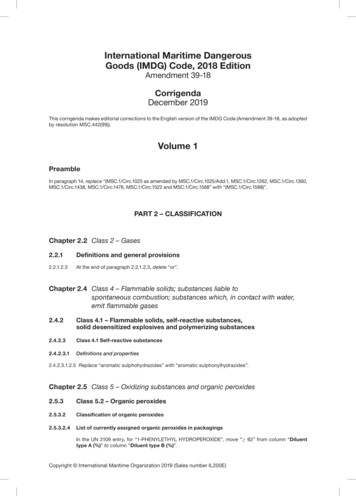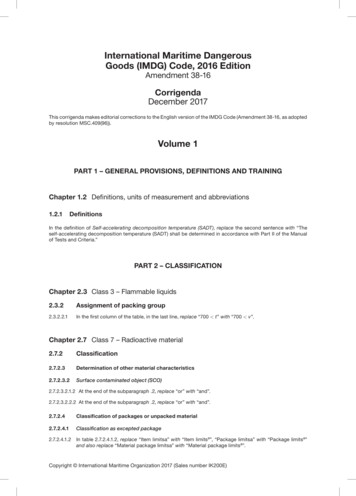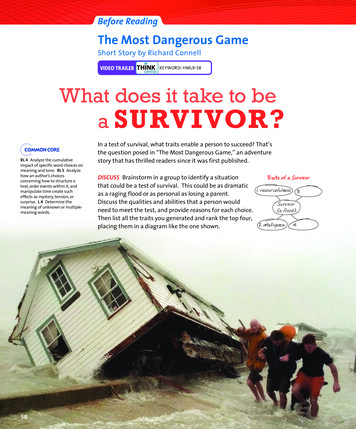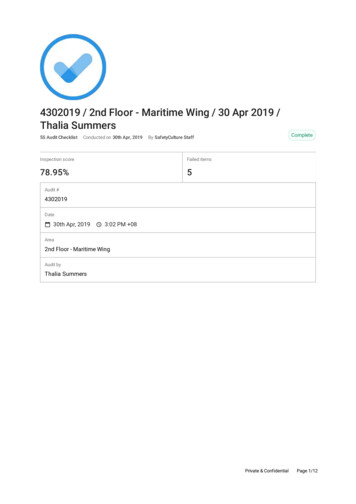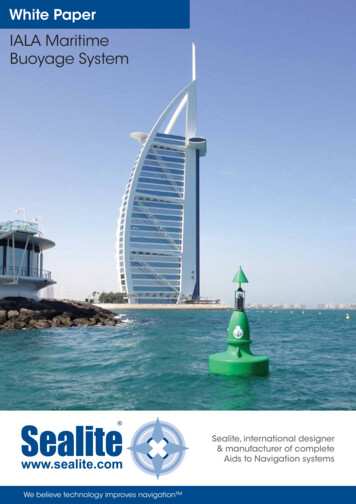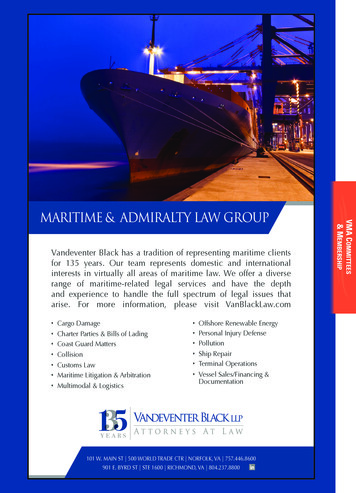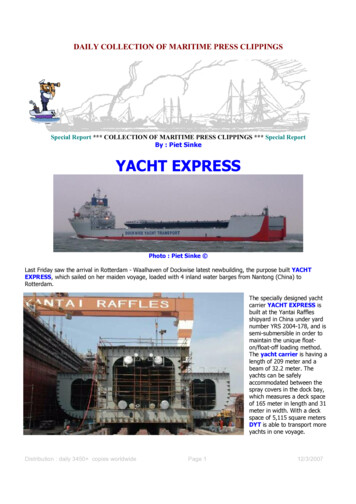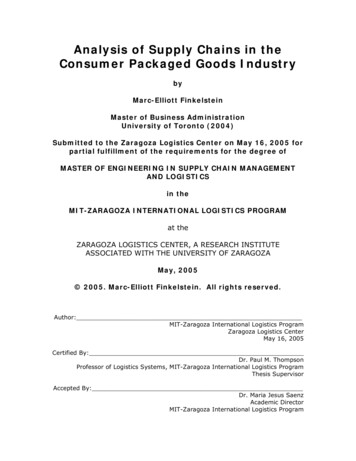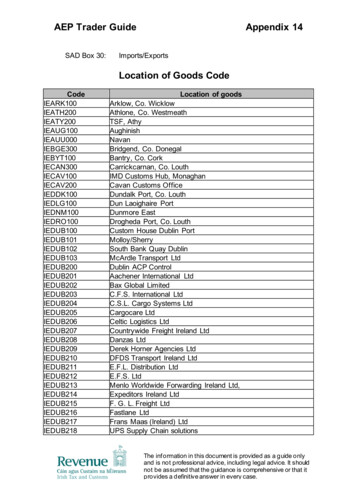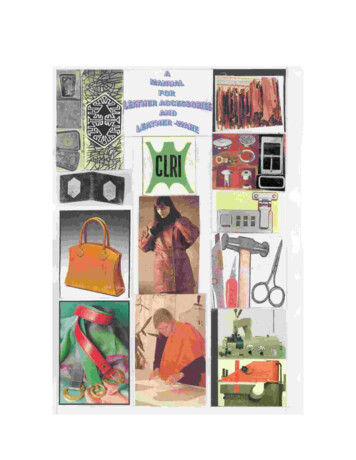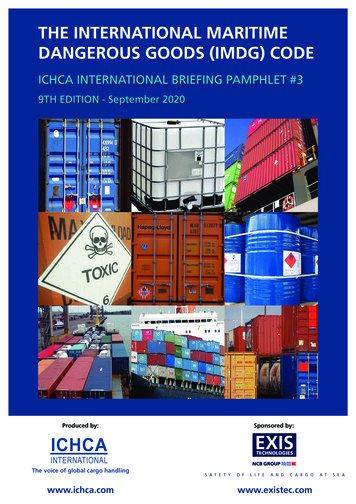
Transcription
THE INTERNATIONAL MARITIMEDANGEROUS GOODS (IMDG) CODEICHCA INTERNATIONAL BRIEFING PAMPHLET #39TH EDITION - September 2020Produced by:Sponsored by:The voice of global cargo handlingwww.ichca.comwww.existec.com
ICHCA INTERNATIONAL www.ichca.comINTRODUCTIONAbout this publicationThis publication is one of an extensive series of briefing pamphlets and other documentsdeveloped by the International Technical Panel of ICHCA International Ltd (ITP). The briefingpamphlet series is designed to provide all those involved in cargo handling, transport andrelated activities with practical advice and regulatory updates related to the safe handling andtransport of cargoes.The goal of the briefing pamphlet series, and a prime focus for the work of ICHCA Internationaland the ITP in general, is to foster a better understanding of how to reduce damage, injury and lossduring handling and transport operations, safeguarding people, cargo, equipment and property.DisclaimerICHCA prepares its publications according to the information available at the time of publication.This publication does not constitute professional advice, nor is it an exhaustive summary of theinformation available on the subject matter to which the publication refers.Publications should always be read in conjunction with the relevant national and internationallegislation and any applicable regulations, standards and codes of practice.Every effort is made to ensure accuracy of the information, but neither ICHCA nor any memberof the ITP is responsible for any loss, damage, costs or expenses incurred (whether or not innegligence) arising from reliance on or interpretation of the publication. The comments set outin this publication are not necessarily the views of ICHCA or any member of the ITP.WarningThis briefing pamphlet necessarily represents a summary of some of the important aspects dealtwith in the IMDG Code. For detailed advice it is essential to refer to the latest version of theCode itself and read this in conjunction with the relevant national legislation.Further AdviceICHCA International provides a technical summary to its members of each set of changes made tothe IMDG Code and also offers a technical advisory service to answer any queries that may arise.For more information, contact the Head of ICHCA International, Richard Brough O.B.E. at tech.advisor@ichca.com.Premium members2THE IMDG CODE ICHCA INTERNATIONAL BRIEFING PAMPHLET #3 9TH EDITION ICHCA International Limited
ICHCA INTERNATIONAL www.ichca.comTABLE OF CONTENTSIntroduction2Chapter 1Status and background4Chapter 2Principles of the IMDG Code5Chapter 3Layout of the IMDG Code6Chapter 4Classification7Chapter 5Marking, Labelling and Placarding10Chapter 6Product containment11Chapter 7Limited Quantities and Excepted Quantities13Chapter 8Documentation14Chapter 9Stowage and segregation14Chapter 10Competent authorities15AppendicesContents table for the IMDG Code 2018 edition16About the author18About the publication sponsors18About ICHCA International and the Technical Panel19ICHCA International LtdRegistered address:F15 The Bloc38 Springfield WayAnlabyHullHU10 6RJEmail onalhttps://www.facebook.com/ICHCAInternational All rights reserved. No part of this publication may be reproduced or copied without ICHCA’s prior written consent.Our thanks to member Exis Technologies for providing many of the photos and graphics included in this publication.First Published1st Revision2nd Revision3rd Revision4th Revision5th Revision6th Revision7th Revision8th Revision1993199520002003200520072009201120149th Revision2020ICHCA International Briefing Pamphlet #3The International MaritimeDangerous Goods (IMDG) CodeISBN: 978-1-85330-001-19th Revision 2020THE IMDG CODE ICHCA INTERNATIONAL BRIEFING PAMPHLET #3 9TH EDITION ICHCA International Limited3
ICHCA INTERNATIONAL www.ichca.com1 STATUS AND BACKGROUNDThe International Maritime Organization (IMO) is thespecialised United Nations agency with responsibilityfor international maritime affairs. Like all UnitedNations agencies, the IMO is made up of MemberStates who are obliged to become contractingparties to IMO’s various international conventions. Inaddition to the Member States, there are a number ofinternational organizations who are concerned withmaritime issues and who have Non-GovernmentalOrganization (NGO) status at IMO. ICHCA InternationalLimited has such status at IMO.1.1 IMO Dangerous Goods ConventionsThere are two international conventions produced byIMO which govern the transport of dangerous goods:1.1.1 SOLASThe International Convention for the Safety of Lifeat Sea, 1974 (1974 SOLAS Convention), as amended,Chapter VII of which deals with the safety aspects ofthe transport of dangerous goods by sea.1.1.2 MARPOLThe International Convention for the Prevention ofPollution from Ships as modified by the Protocol of1978 (MARPOL 73/78), Chapter III of which deals withprevention of pollution arising from the transportof dangerous goods by sea.1.2 The IMDG CodeAll IMO Member States are required to implementnational legislation to address the transport ofdangerous goods, through their legal obligationsunder the SOLAS and MARPOL Conventions. However,to assist them, the IMO has produced a detailed setof requirements covering the transport of packageddangerous goods by sea in a separate Code; theInternational Maritime Dangerous Goods (IMDG) Code.Key2017 Year when single amendmentonly is valid Transition year when eitheramendment is valid4The requirements of the IMDG Code are basedupon the Model Regulations (known as the ‘OrangeBook’) produced by the United Nations Committeeof Experts on the Transport of Dangerous Goods inGeneva, together with a number of recommendationsfor good practice. The requirements of the IMDGCode are published in 2 volumes with an additionalSupplement volume, which contains a number ofindividual IMO related publications.1.2.1 AdoptionMost parts of the IMDG Code became mandatoryon 1st January 2004, under the mandatoryrequirements of the SOLAS Convention. While mostMember States have incorporated the requirementsof the IMDG Code without further amendmentinto their national legislation, others have appliedsome different (usually more stringent) nationalrequirements in addition to those of the IMDG Code.When shipping dangerous goods, it is important tobe aware of any further restrictions or requirements,which may apply in a particular country, in additionto the IMDG Code.1.2.2 Shoreside TrainingTraining of shoreside personnel involved inpackaged dangerous goods shipments was mademandatory from 1 January 2010. Only paragraphs1.3.1.4 to 1.3.1.7 (which deal with training content)remain recommendatory.1.2.3 FrequencyThe IMDG Code is updated on a two-yearly basiswith each amendment valid for up to three years.Amendments overlap each other so that there isalways a transition period for industry to make thenecessary adjustments to the latest amendment.201820192020202238 - 1639 - 18THE IMDG CODE ICHCA INTERNATIONAL BRIEFING PAMPHLET #3 9TH EDITION ICHCA International Limited202140 - 202023
ICHCA INTERNATIONAL www.ichca.comAmendment 39-18, including a new edition of thesupplement, was published on 1st January 2019 andbecame mandatory on 1st January 2020.Amendment work is undertaken by the SubCommittee on Carriage of Cargoes and Containers(CCC) In addition to incorporating amendments arisingfrom the United Nations Committee of Experts inGeneva, the Sub-Committee also considers proposalsfor amendments prepared by IMO’s Member States.All amendments must be approved by IMO’s mostsenior technical committee, the Maritime SafetyCommittee (MSC), before they can be published in thenext edition of the IMDG Code.As a result of the two-yearly cycle of amendments, acompletely new edition of the IMDG Code is publishedevery two years. Following publication, an errata maybe issued with additional changes or to correct anyprinting errors which may have arisen.It is extremely important to ensure that the detailson any errata issued are incorporated into the IMDGCode and taken into account at the appropriate time.2 PRINCIPLES OF THE IMDG CODEThe IMDG Code is based on an internationally agreed system which:1Groups dangerous goods together based on the hazards they present intransport (classification)2Contains the dangerous goods in packagings/tanks which are ofappropriate strength and which will prevent the goods escaping3Uses hazard warning labels and other identifying marks to identifydangerous goods in transport4Requires standard documentation to be provided when dangerous goodsare being transported5Lays down principles for ensuring that incompatible dangerous goods arekept apart6Lays down principles for where to place dangerous goods on board shipto ensure safe transport7Provides emergency response advice for dangerous goods involved in afire or spillage on board shipTHE IMDG CODE ICHCA INTERNATIONAL BRIEFING PAMPHLET #3 9TH EDITION ICHCA International Limited5
ICHCA INTERNATIONAL www.ichca.com3 LAYOUT OF THE IMDG CODE3.1 FormatThe IMDG Code adopts a standard referencebook format with an introduction, main contents,appendices and an index. Its layout has beenharmonised with that of the United Nations ModelRegulations (the Orange Book) which forms the basisof all international modal regulations covering thetransport of dangerous goods (i.e. road, rail, inlandwaterway, air and sea).Consequently, the multimodal shipper should be ableto find the same information in the same part of theinternational regulations, no matter what form oftransport is being used.3.2 Dangerous Goods ListThe Dangerous Goods List (DGL) is the core of theIMDG Code. This contains a list of all the dangerousgoods assigned under the United Nations systemin numerical (UN Number) order (see 4.2 below),together with their specific transport requirements ina coded system.63.3 VolumesThe Code is presented in two main books, Volume1 and Volume 2 with a third Supplement volumecontaining related IMO publications and IMOresolutions. It is necessary to use the first two volumesto obtain the required information when shippingdangerous goods by sea.3.3.1 Volume 1Volume 1 contains Parts 1, 2, 4, 5, 6 and 7.3.3.2 Volume 2Volume 2 is comprised mainly of Part 3 which containsthe DGL, a list of all the dangerous goods in UN Numberorder, together with their transport requirements ina coded system presented in 18 columns, of whichcolumns 7 and 16 are divided into two parts (a and b).THE IMDG CODE ICHCA INTERNATIONAL BRIEFING PAMPHLET #3 9TH EDITION ICHCA International Limited
ICHCA INTERNATIONAL www.ichca.comThe transport requirements contained in the DGLinclude: Special provisions applicable to certain substancesand articles in the DGL Limited quantity and excepted quantity provisions Stowage and segregation requirements Packaging and tank requirementsThis volume also has two appendices and analphabetical list of the substances, materials andarticles listed in the DGL.Details of the contents of each of the above parts arereproduced in the Appendix of this briefing pamphlet.3.3.3 Supplement VolumeThe Supplement volume comprises a number ofseparate IMO publications that relate to the IMDGCode, these include Emergency Procedures (EmS) for use on ships in theevent of an accident (e.g. spillage or fire). Medical First Aid Guide (MFAG) for use on ships inaccidents involving dangerous goods. Reporting procedures, for use by ships to reportincidents involving dangerous goods, harmfulsubstances, and/or marine pollutants. Recommendations on the Safe Use of Pesticides inShips (e.g. fumigation). Irradiated Nuclear Fuel (INF) Code. Various relevant IMO Resolutions, Circulars, etc.4 CLASSIFICATION4.1 PurposeThe primary purpose of the IMDG Code’s classificationsystem is to: Identify goods which are considered to bedangerous for transport. Identify the dangers which are presented bydangerous goods in transport. Ensure that the correct measures are taken toenable these goods to be transported safelywithout risk to persons or the environment (bothwithin the port and on the ship). Avoid mis-pronouncing / mis-spelling complicatedchemical names (e.g. ISOCYANATOBENZOTRIFLUORIDES UN 2285)UN Numbers starting with “0” are allocated to UN Class1 Explosives while UN Numbers starting with “1”, “2”or “3” are used to identify goods of any other class.4.2 UN NumbersUN Numbers are unique 4 figure, Arabic numeralnumbers allocated by the UN Committee of Expertson the Transport of Dangerous Goods to specific orgeneric Proper Shipping Names (PSNs) in order to: Overcome language barriers (e.g. NITROUS OXIDE HEMIOXIDE D’AZOTE DISTICK STUFFOXIDE) Avoid confusion caused by similar names (e.g.SULPHURYL CHLORIDE, UN 1834 and SULPHURYLFLUORIDE, UN 2191)4.3 Proper Shipping NamesEach UN Number is allocated a Proper Shipping Name(PSN). The PSN is the accepted name which mustbe used for transport purposes on documentation,packagings, etc.The UN Number for a substance or article must bequoted whenever there is a need for identificationsuch as in an incident and must appear oncontainment systems and on documentation.The PSN is that portion of the entry in the DGLwhich is shown in upper-case characters (plus anynumbers, Greek letters, ‘sec’, ‘tert’, and the lettersm, n, o, p, which form an integral part of the name).THE IMDG CODE ICHCA INTERNATIONAL BRIEFING PAMPHLET #3 9TH EDITION ICHCA International Limited7
ICHCA INTERNATIONAL www.ichca.comClassType of Danger1Explosives2Gases (sub-divided as follows)2.1 Flammable gases2.2 Non-flammable, non-toxic gases2.3 Toxic gases3Flammable liquids4Flammable solids, substances liable to spontaneous combustion and substances which,in contact with water, emit flammable gases (sub-divided as follows)Class 4.1 Flammable solidsClass 4.2 Substances liable to spontaneous combustionCl
THE IMDG CODE ICHCA INTERNATIONAL BRIEFING PAMPHLET #3 9TH EDITION ICHCA International Limited 7 4 CLASSIFICATION 4.1 Purpose The primary purpose of the IMDG Code’s classification system is to: Identify goods which are considered to be dangerous for transport. Identify the dangers which are presented by dangerous goods in transport.
